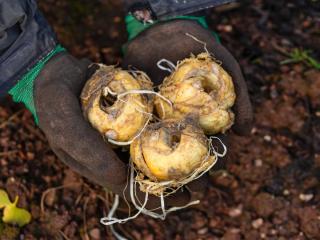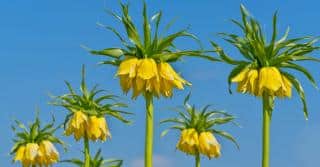

The crown imperial is a unique and very decorative flower bulb.
Core Crown Imperial facts
Name – Fritillaria imperialis
Family – Liliaceae (lily family)
Type – spring bulb
Height – 8 to 40 inches (20 to 100 cm)
Exposure – full sun, part sun
Soil – ordinary, well drained
Flowering – April to June
Its inflorescence is spectacular and it grows very well in our climates. Its early blooming makes it one of the first flowers to flower in spring.
Crown imperial has evolved into a great number of species, and they all bloom in spring.
One preferably plants crown imperial bulbs in September-October, to a depth of at least 4 inches (10 cm).
 Just remember that the planting depth is more or less always 3 times as deep as the bulb is tall, that’s why it varies from 4 to 8 inches (10 to 20 cm) in depth. Space each bulb 16 inches (40 cm) apart.
Just remember that the planting depth is more or less always 3 times as deep as the bulb is tall, that’s why it varies from 4 to 8 inches (10 to 20 cm) in depth. Space each bulb 16 inches (40 cm) apart.
This plant is a perennial and will bloom again from one year to the next.
In order to extend its lifespan and see the flowers bloom innumerable and luminous, regenerate the bulbs every 2 or 3 years.
The crown imperial requires rich soil, which is why you should fertilize the ground whenever you notice that your plant is diminishing in vigor.
As for watering, it will only be needed in case of extended dry spell, but since the flowering usually takes place in spring, this is really exceptional in temperate climates.
The leafage must not be cut off until it has withered away completely. Indeed, the phase where the leaves turn yellow is exactly when the plant stocks up on nutrients for the next blooming cycle.
It puts forth remarkable distinctive flowers, with very long scapes bearing drooping bells that are yellow, red or white depending on the variety.
 Crown imperial also has the added characteristic of keeping rodents at bay, possibly because its bulbs have a very pungent smell.
Crown imperial also has the added characteristic of keeping rodents at bay, possibly because its bulbs have a very pungent smell.
For the tallest scapes, feel free to stake them so that they don’t bend over, especially if you live in a windy spot!
I love your site and can’t wait to get my bulbs in the spring
Thank you very much, Jan! I’m sure you’ll be thrilled, these really look very nice!